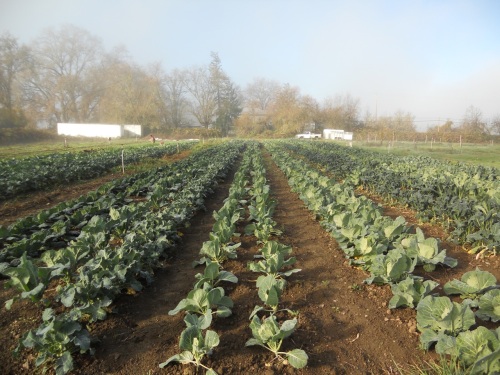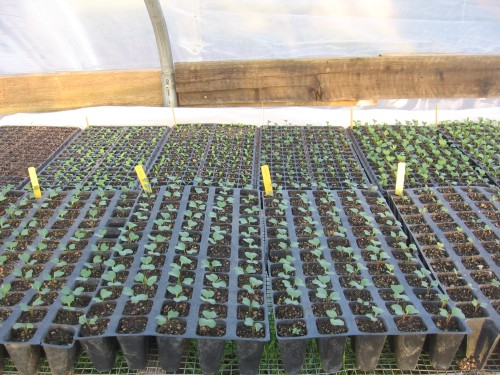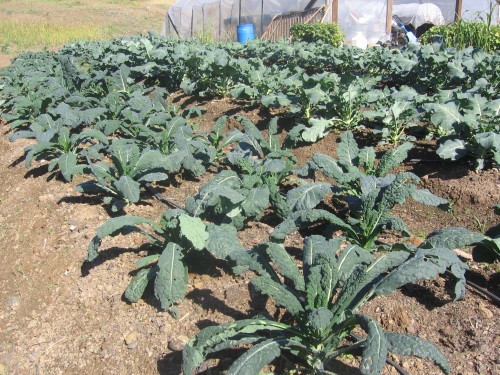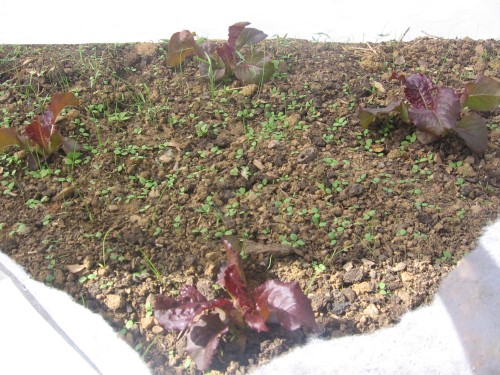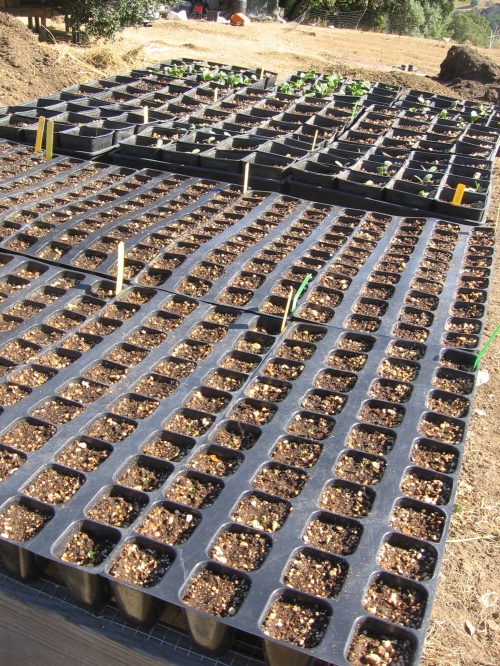December 15, 2009
ANNOUNCEMENTS
- There is no CSA delivery Saturday, December 26 and Tuesday, December 29th. Deliveries will resume Saturday, January 2. The CSA has only this one week off between now and the end of April.
- If you are using the baskets, please label your basket(s) with your name. We ordered more baskets, but the basket company did not ship them when promised, so we do not know for sure when they will arrive. Thanks for bearing with us.
IN YOUR BASKET THIS WEEK
Garlic
Butternut Squash
Collard Greens
Spinach
Flashy Trout Back Romaine Lettuce
Cauliflower or Broccoli
NOTES FROM THE FIELD
With the rain has come a little warmth compared to last week. It’s tougher weeding the wet soil, but we’re still able to do more planting. That includes cover cropping a couple areas of the ranch where we hope to grow more vegetables in the future.
The broccoli and cauliflower must be harvested when they are ready, so that is why you will get one or the other. They are highly perishable, especially in this wet weather. The Brussels sprouts have a bit more maturing to do, but many of the cabbage are starting to get full heads.

oliver Brussels sprouts
We have also been planting more lettuce where we have harvested spinach. Along with many of the greens, we have to cover those crops with row cover – woven, breathable blankets – to protect them from birds and/or light frost. Last week, unfortunately, we learned that this does not protect the crops from bears (not that we expected it would). We don’t usually see signs of bears in the vegetable garden, although one morning, we found the bed of red Russian kale trampled down. About 60% of the plants were thrashed. The paw prints on the row cover appeared to be bears, and the following evening, we spotted two of them outside the deer fence and not far from the garden. Since then, in the evening before heading home, we drive by the garden to make sure they have not returned. And for extra measure, we yell and bark wildly out the truck window to scare away any creatures that may be hanging near the garden in the dark. Farming in close proximity to nature is a delicate balance.
Eat well!
Adam & Paula

Pulling back the row cover, you see the damage done. The trampled and torn leaves were fed to the pigs.
Martha Shulman’s Collard Greens w/ Barley or Farro (from the New York Times website)
This recipe calls for farro, but barley may be substituted. Farro with anything is comfort food, and the combination of farro and collard greens is particularly hearty and nutritious. The time required to cook the farro or barley will depend on how long it has been sitting on your shelf. When it’s less than a year old, farro softens nicely. The older it is, the longer it will need to cook. Soak the farro or barley if you aren’t sure how old it is.
1 large bunch collard greens, stemmed, leaves washed
Salt to taste
2 tablespoons extra virgin oliv oil
½ medium onion, chopped
2 large garlic cloves, minced
1 teaspoon chopped fresh rosemary
1 ½ cups farro
½ cup dry white wine
2 quarts chicken stock, vegetable stock, or water, or 1
quart each
¼ cup finely chopped flat-leaf parsley
1. Cut the collard greens into strips one inceh wide after stripping the stems.
2. Heat the olive oil over medium heat in a wide, heavy saucepan or Dutch oven, and add the onion. Cook, stirring, until tender, about five minutes. Add a generous pinch of salt, the garlic and the rosemary, and continue to cook for another minute, until the garlic is fragrant. Stir in the faro or barley, and mix for a couple of minutes. Add the white wine, and stir until it has reduced by half. Add the stock and/or water and salt, and bring to a boil. Reduce the heat, stir in the collard greens, cover and simmer 45 minutes, or until the farro or barley is tender. Drain any water remaining, and return the mixture to the pan. Taste and adjust seasonings. Sprinkle a little feta over each serving if desired.
Serves 6
It will keep for two or three days in the refrigerator and reheats well.
Read Full Post »
